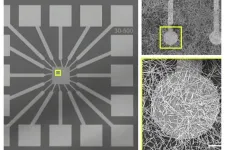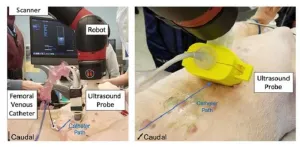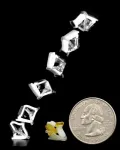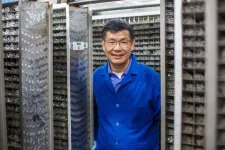(Press-News.org) FINDINGS
An experimental computing system physically modeled after the biological brain “learned” to identify handwritten numbers with an overall accuracy of 93.4%. The key innovation in the experiment was a new training algorithm that gave the system continuous information about its success at the task in real time while it learned.
The algorithm outperformed a conventional machine-learning approach in which training was performed after a batch of data has been processed, producing 91.4% accuracy. The researchers also showed that memory of past inputs stored in the system itself enhanced learning. In contrast, other computing approaches store memory within software or hardware separate from a device’s processor.
BACKGROUND
For 15 years, researchers at the California NanoSystems Institute at UCLA, or CNSI, have been developing a new platform technology for computation. The technology is a brain-inspired system composed of a tangled-up network of wires containing silver, laid on a bed of electrodes. The system receives input and produces output via pulses of electricity. The individual wires are so small that their diameter is measured on the nanoscale, in billionths of a meter.
The “tiny silver brains” are very different from today’s computers, which contain separate memory and processing modules made from atoms whose positions do not change as electrons flow through them. In contrast, the nanowire network physically reconfigures in response to stimulus, with memory based on its atomic structure and spread throughout the system. Where wires overlap, connections can form or break — analogous to the behavior of synapses in the biological brain where neurons communicate with one another.
Collaborators in the research, at the University of Sydney, developed a streamlined algorithm for providing input and interpreting output. The algorithm is customized to exploit the system’s brain-like ability to change dynamically and to process multiple streams of data simultaneously.
METHOD
The brain-like system was made up of a material containing silver and selenium, which was allowed to self-organize into a network of entangled nanowires on top of an array of 16 electrodes. Scientists trained and tested the nanowire network using images of handwritten numbers, a dataset created by the National Institute of Standards and Technology and often used for benchmarking machine-learning systems. Images were communicated to the system pixel-by-pixel using pulses of electricity each lasting one-thousandth of a second, with differing voltages representing light or dark pixels.
IMPACT
Still in development, the nanowire network is expected to require far less power than silicon-based artificial intelligence systems to perform similar tasks. The network also shows promise at tasks that current AI struggles to accomplish: making sense of complex data, such as patterns in weather, traffic and other systems that change over time. To do so, today’s AI requires tremendous amounts of training data and extremely high energy expenditures.
With the type of co-design used in this study — hardware and software developed in tandem — nanowire networks may ultimately serve a complementary role alongside silicon-based electronic devices. Brain-like memory and processing embedded in physical systems capable of continuous adapting and learning may be particularly well-suited to so-called “edge computing,” which processes complex data on the spot without requiring communication with far-off servers. Potential uses include robotics, autonomous navigation in machines such as vehicles and drones, and the smart device technology that makes up the Internet of Things, as well as health monitoring and coordinating measurements from sensors in multiple locations.
AUTHORS
The corresponding authors of the study are James Gimzewski, a UCLA distinguished professor of chemistry and CNSI member; Adam Stieg, a UCLA research scientist and associate director of the CNSI; Zdenka Kuncic, a professor of physics at the University of Sydney; and Ruomin Zhu, a University of Sydney doctoral student who is also first author. Other co-authors are Sam Lilak, who received his doctorate from UCLA in 2022; and Alon Loeffler and Joseph Lizier of the University of Sydney.
JOURNAL
The study was published in Nature Communications.
FUNDING
The study was supported by the University of Sydney and the Australian-American Fulbright Commission.
END
Experimental brain-like computing system more accurate with custom algorithm
2023-11-13
ELSE PRESS RELEASES FROM THIS DATE:
Researchers develop gel to deliver cancer drugs for solid tumors
2023-11-13
Intratumoral therapy – in which cancer drugs are injected directly into tumors – is a promising treatment option for solid cancers but has shown limited success in clinical trials due to an inability to precisely deliver the drug and because most immunotherapies quickly dissipate from the site of injection. A team of researchers from Mass General Brigham, in collaboration with colleagues at the Koch Institute for Integrative Cancer Research, has developed a gel delivery system that overcomes these challenges. The gel is injectable but solidifies upon delivery; contains an imaging agent for visualization under CT scan; and can hold a high ...
Using deep learning to process raw photoacoustic channel data and guide cardiac interventions
2023-11-13
Cardiovascular diseases rank among the top causes of death across the world, and cardiac interventions are similarly very common. For example, cardiac catheter ablation procedures, which are used to treat arrythmias, number in several tens of thousands per year in the US alone. In these procedures, surgeons insert a thin, flexible tube called a catheter into the femoral vein in the leg and navigate their way up to the heart, where the problematic tissue is destroyed using cold or focused radiation.
Even though cardiac catheter-based procedures are considered minimally invasive, the position ...
The Long Jump: Athletic, insect-scale long jumping robots reach where others can't.
2023-11-13
A team of engineers from the University of Illinois has published the first known study documenting the long-jumping motion of 3D-printed insect-scale robots.
The new study, published in the journal Smart Materials and Structures, follows a previous publication that documented the same lab’s investigation of vertical jumping in insect-scale robots. The study is led by Professor Sameh Tawfick, an associate professor and Ralph A. Andersen Faculty Scholar in the Department of Mechanical Science and Engineering. His lab, the Kinetic Materials Research Group, studies the ...
UMD engineers’ ‘cooling glass’ blasts building heat into space
2023-11-13
University of Maryland researchers aiming to combat rising global temperatures have developed a new “cooling glass” that can turn down the heat indoors without electricity by drawing on the cold depths of space.
The new technology, a microporous glass coating described in a paper published in the journal Science, can lower the temperature of the material beneath it by 3.5 degrees Celsius at noon, and has the potential to reduce a mid-rise apartment building’s yearly carbon emissions by 10%, according to the research team led by Distinguished University Professor Liangbing Hu in the Department of Materials ...
University of Oklahoma engineer elected as fellow member of Optica
2023-11-13
Optica, an international association in optics and photonics, recently announced the election of University of Oklahoma engineering professor Javier Jo, Ph.D., as a Fellow member.
Jo, a faculty member in the School of Electrical and Computer Engineering, was honored for his contributions to integrating optical imaging and artificial intelligence for biomedical applications. His research focuses on developing optical sensing and imaging technologies to understand pathophysiological mechanisms in human diseases and improve their clinical management.
“Dr. Jo’s ...
University of Toronto Engineering study finds bigger datasets might not always be better for AI models
2023-11-13
From ChatGPT to DALL-E, deep learning artificial intelligence (AI) algorithms are being applied to an ever-growing range of fields. A new study from University of Toronto Engineering researchers, published in Nature Communications, suggests that one of the fundamental assumptions of deep learning models — that they require enormous amounts of training data — may not be as solid as once thought.
Professor Jason Hattrick-Simpers and his team are focused on the design of next-generation materials, from catalysts that convert captured carbon into fuels to non-stick surfaces that keep airplane wings ice-free.
One ...
Acupuncture may offer limited relief to patients with chronic hives
2023-11-13
Annals of Internal Medicine Tip Sheet
@Annalsofim
Below please find summaries of new articles that will be published in the next issue of Annals of Internal Medicine. The summaries are not intended to substitute for the full articles as a source of information. This information is under strict embargo and by taking it into possession, media representatives are committing to the terms of the embargo not only on their own behalf, but also on behalf of the organization they represent.
----------------------------
1. Acupuncture may offer limited relief to patients with chronic hives
Abstract: https://www.acpjournals.org/doi/10.7326/M23-1043
Editorial: ...
Virologic rebound observed in 20% of patients treated with nirmatrelvir-ritonavir
2023-11-13
Embargoed for release until 5:00 p.m. ET on Monday 13 November 2023
Annals of Internal Medicine Tip Sheet
@Annalsofim
Below please find summaries of new articles that will be published in the next issue of Annals of Internal Medicine. The summaries are not intended to substitute for the full articles as a source of information. This information is under strict embargo and by taking it into possession, media representatives are committing to the terms of the embargo not only on their own behalf, but also on behalf ...
One in five patients experience rebound COVID after taking Paxlovid, new study finds
2023-11-13
A new study by investigators from Mass General Brigham found that one in five individuals taking Nirmatrelvir-ritonavir therapy, commonly known as Paxlovid, to treat severe symptoms of COVID-19, experienced a positive test result and shedding of live and potentially contagious virus following an initial recovery and negative test—a phenomenon known as virologic rebound. By contrast, people not taking Paxlovid only experienced rebound about 2 percent of the time. Results are published in Annals of Internal Medicine.
“We conducted this study to address lingering questions about Paxlovid and virologic rebound in COVID-19 treatment,” said corresponding ...
Scientists discover key to a potential natural cancer treatment’s potency
2023-11-13
JUPITER, Fla. — Slumbering among thousands of bacterial strains in a collection of natural specimens at The Herbert Wertheim UF Scripps Institute for Biomedical Innovation & Technology, several fragile vials held something unexpected, and possibly very useful.
Writing in the journal Nature Chemical Biology, a team led by chemist Ben Shen, Ph.D., described discovery of two new enzymes, ones with uniquely useful properties that could help in the fight against human diseases including cancer. The discovery, published ...




